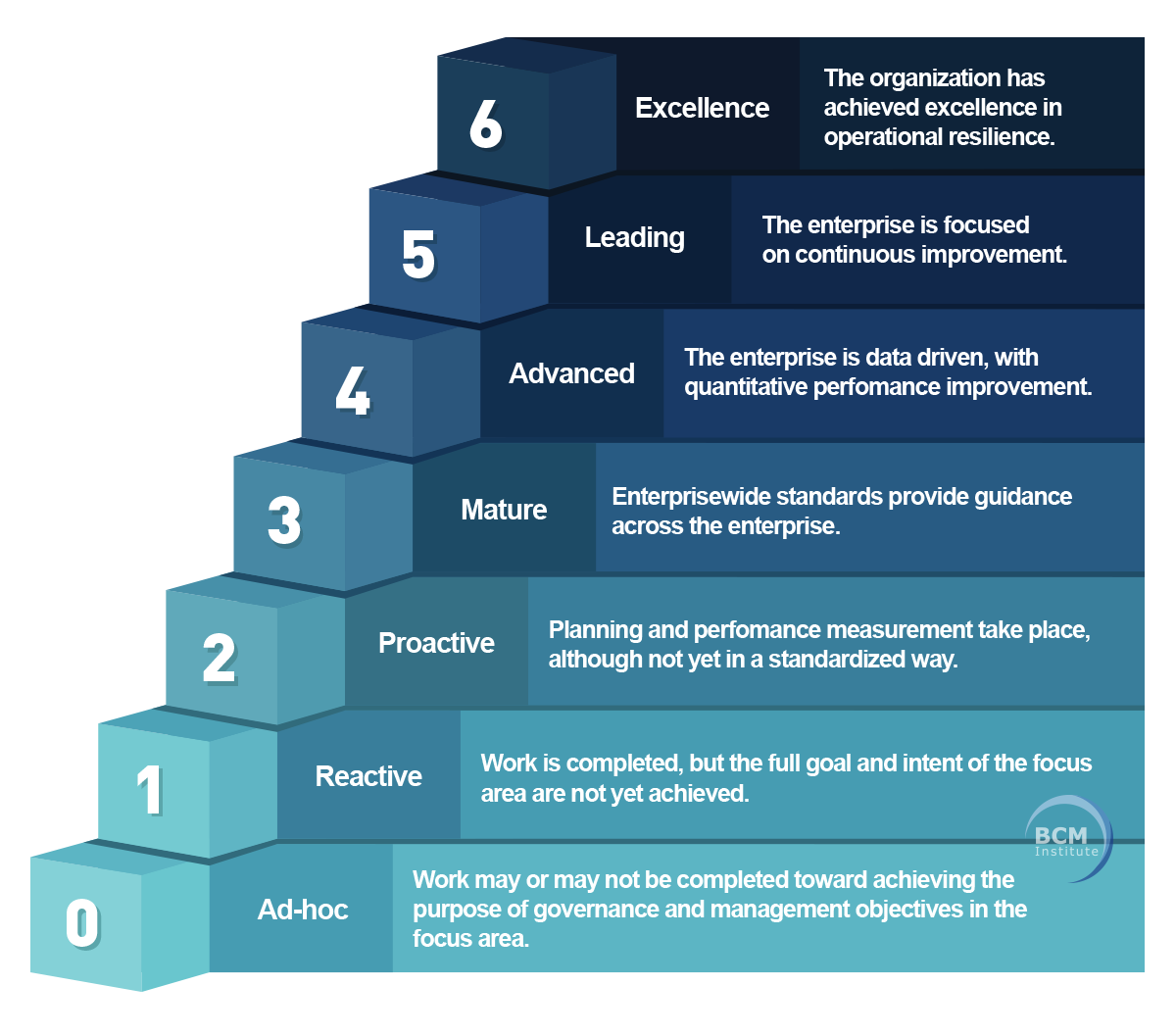Operational Resilience Maturity-level Model

 Operational resilience is the ability of an organization to withstand and recover from operational disruptions, whether caused by internal or external events.
Operational resilience is the ability of an organization to withstand and recover from operational disruptions, whether caused by internal or external events.
Operational resilience involves identifying critical business services and ensuring they can continue operating during an operational disruption.
It also consists of developing plans to recover from the interruption and return to normal operations as quickly as possible.
|
 Developing a maturity-level model for focus areas for operational resilience is a helpful tool for organizations to understand their current operational resilience and identify areas for improvement to upgrade to the next level of maturity. Developing a maturity-level model for focus areas for operational resilience is a helpful tool for organizations to understand their current operational resilience and identify areas for improvement to upgrade to the next level of maturity.
This article will discuss the seven levels of a maturity-level model for focus areas when implementing operational resilience and their specific requirements.
|
 |

Operational Resilience Maturity-level Model for Focus Areas
Level 0: Ad-hoc
|
The organisation does not have the following:
- Any formal approach to operational resilience.
- Any processes or controls in place to manage disruptions.
The requirements at level 0 are to:
- Establish basic controls to manage disruptions.
- Ensure that staff are aware of the organization's expectations.
|
Level 1: Reactive
|
The organisation has:
- A proactive approach to operational resilience.
- Established processes to manage risk.
- The ability to identify potential operational disruptions before they occur.
The requirements at level 1 are to:
- Develop and implement a comprehensive risk management framework.
- Establish processes for monitoring and reporting on risk.
|
Level 2: Proactive
|
The organisation has:
- A proactive approach to operational resilience.
- An established set of processes to manage risk
- The ability to identify potential disruptions before they occur.
The requirements at level 2 are to:
- Develop and implement a comprehensive risk management framework.
- Establish processes for monitoring and reporting on risk.
|
Level 3: Mature
|
The organisation has:
- A mature approach to operational resilience.
- A comprehensive risk management framework
- The ability to identify and manage risks effectively.
The requirements at level 3 are to:
- Establish a culture of continuous improvement
- Ensure that staff are trained on the organization's approach to operational resilience.
|
Level 4: Advanced
|
The organisation has:
- An advanced approach to operational resilience.
- The ability to manage complex risks
- The ability to adapt its approach to operational resilience to meet changing business needs.
The requirements at level 4 are to:
- Establish a comprehensive business continuity management framework
- Ensure that staff are trained on the organization's approach to operational resilience.
|
Level 5: Leading
|
The organisation has:
- Established best practices for managing risk
- The ability to adapt to changing business needs.
- The ability to continuously improve its approach to operational resilience
- The ability to share knowledge with others.
The requirements at level 5 are to:
- Establish a culture of innovation
- Continuously improve the organization's approach to operational resilience.
|
Level 6: Excellence
|
The organisation has:
- Achieved excellence in operational resilience.
- A comprehensive understanding of its risk profile.
- The ability to manage risk effectively.
- The ability to adapt to changing business needs.
- The ability to share knowledge with others.
The requirements at level 6 are to:
- Establish a culture of excellence
- Ensure that staff are trained on the organization's approach to operational resilience.
|
| |
Summing Up ...
In conclusion, a maturity-level model for focus areas is essential for organizations seeking to implement operational resilience.
By understanding the seven levels of the model and their specific requirements, organizations can develop and improve their approach to managing risk and disruptions.
This, in turn, can help organizations continue delivering critical services in the face of unexpected disruptions.
More Information About Blended Learning OR-5000 [BL-OR-5] or OR-300 [BL-OR-3]
To learn more about the course and schedule, click the buttons below for the OR-3 Blended Learning OR-300 Operational Resilience Implementer course and the OR-5 Blended Learning OR-5000 Operational Resilience Expert Implementer course.
 Operational resilience is the ability of an organization to withstand and recover from operational disruptions, whether caused by internal or external events.
Operational resilience is the ability of an organization to withstand and recover from operational disruptions, whether caused by internal or external events.





![[BL-OR] [3-4-5] View Schedule](https://no-cache.hubspot.com/cta/default/3893111/d0d733a1-16c0-4b68-a26d-adbfd4fc6069.png)
![[BL-OR] [3] FAQ OR-300](https://no-cache.hubspot.com/cta/default/3893111/f20c71b4-f5e8-4aa5-8056-c374ca33a091.png)








![Email to Sales Team [BCM Institute]](https://no-cache.hubspot.com/cta/default/3893111/3c53daeb-2836-4843-b0e0-645baee2ab9e.png)


